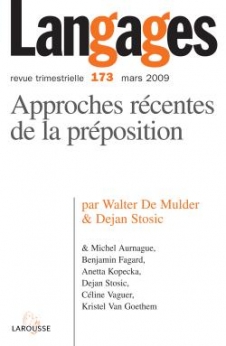
Langages n° 173 (1/2009)
Pour acheter ce numéro, contactez-nous
Recevez les numéros de l'année en cours et accédez à l'intégralité des articles en ligne.
Dans cet article, nous nous proposons d’examiner et de comparer le fonctionnement sémantique de la préposition à travers en français et celui de la préposition kroz en serbe en nous limitant à leurs usages spatiaux (ex. Jean se promène à travers la forêt). La mise en parallèle des deux marqueurs se justifie par le fait que, dans l’expression du déplacement, la préposition kroz peut être considérée comme le meilleur équivalent de la préposition à travers.
This corpus-based paper compares the French preposition à travers ‘through’ to its Serbian equivalent kroz ‘through’ in the expression of motion (e.g. Jean se promène à travers la forêt ‘John is walking through the forest’). We first show that the preposition à travers can be described by the notion of “guidance” which is conceived as a “family resemblance” that we propose to describe by seven semantic features : Dynamicity, Interiority, Unicity of the Ground, Opposition to motion, Lateral orientation, Minimal trajectory and Focus on the trajectory through the Ground. Next, we examine the validity of the concept of “guidance” for the Serbian preposition kroz which most frequently translates à travers. The comparison shows that while the features summed up above for à travers can also be used to analyze the spatial meaning of kroz, some of them are more salient in French, whereas others are more salient in Serbian. So, it is the degree of salience of these features that is the main factor responsible for different distributions of à travers and kroz in French and Serbian.

